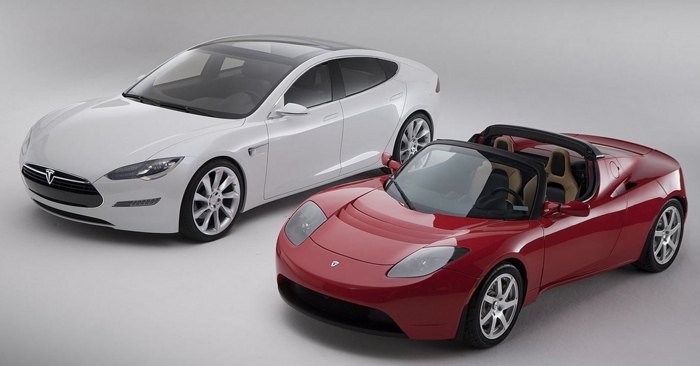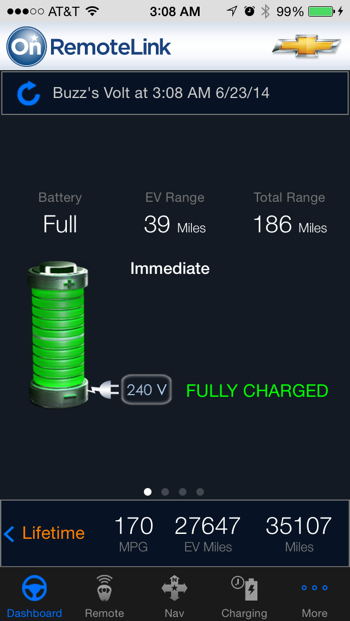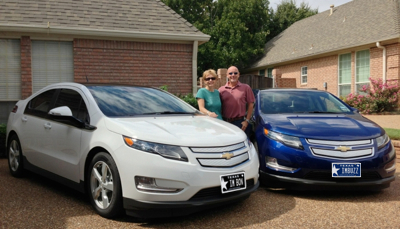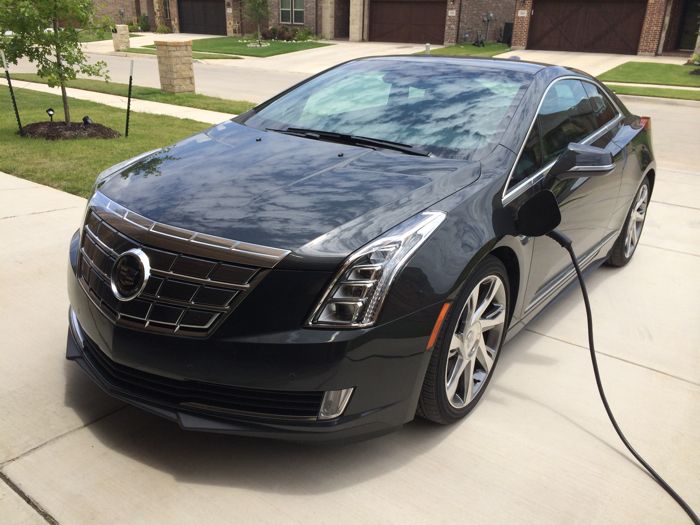As you may already know, my wife Bonnie and I drive Chevrolet Volts and love them. We lease ours and I recommend anyone, driving 15,000 miles per year or less, do the same. The current generation of electric vehicles is still in its infancy. There are many advances coming, and prices will continue to come down. This is great news for those who have not yet gotten an EV and for those who lease them. For those who buy, not so much. The year after we got our Volts, GM announced a $5,000 price reduction. If we had purchased our cars, we would have taken a pretty substantial hit in resale value. We would have bought, if we had intended on keeping the cars for eight or more years, because the difference in depreciation, when compared to traditional cars, would (theoretically) have been negligible by then. By leasing, we insulated ourselves from depreciation worries, knowing we would upgrade to the latest and greatest technology after a few years. This was also our first dip into the EV pool, and we wanted to be protected from any battery life issues. Fortunately, it appears battery life on the Volt is a non-issue. I have thirteen months left on my lease and Bonnie has eighteen months left on hers. So, we’ve been looking around at the new EVs and Plug-in hybrids, considering our next move.
 I’ve often said my next vehicle would be a Tesla. I have wanted the Roadster since I first saw photos of one. However, in speaking with owners of Tesla Roadsters, I have found a common complaint concerns the constant squeaking of the composite parts used in the vehicle. I’ve come to love the silence of the Volt and squeaking would be a deal killer for me.
I’ve often said my next vehicle would be a Tesla. I have wanted the Roadster since I first saw photos of one. However, in speaking with owners of Tesla Roadsters, I have found a common complaint concerns the constant squeaking of the composite parts used in the vehicle. I’ve come to love the silence of the Volt and squeaking would be a deal killer for me.
 On to the next Tesla: the Model S. There are three versions, one with a 60 kWh battery, the next with an 85 kWh battery and lastly (and lustily), the 85 kWh “Performance.” I (of course) want the 85 kWh Performance Model S. The Tesla Model S Financing page shows the “effective monthly cost” of these as $678, $857, and $1,099 respectively. The devil’s in the details, and in this case it’s the “effective” in the “effective monthly cost.” Tesla arrives at this monthly cost by financing the Model S over 72 months with a 10% down payment.
On to the next Tesla: the Model S. There are three versions, one with a 60 kWh battery, the next with an 85 kWh battery and lastly (and lustily), the 85 kWh “Performance.” I (of course) want the 85 kWh Performance Model S. The Tesla Model S Financing page shows the “effective monthly cost” of these as $678, $857, and $1,099 respectively. The devil’s in the details, and in this case it’s the “effective” in the “effective monthly cost.” Tesla arrives at this monthly cost by financing the Model S over 72 months with a 10% down payment.
After that, it gets a bit shaky.
On the Tesla site, the federal income tax credit is factored into the down payment, but that would be true of any EV or plug-in hybrid I would consider getting. So if that is used to reduce the “effective monthly cost” of the Model S, it would also do the same for any other vehicle I’m evaluating. In other words, it’s a wash. (Since the 10% down payment on the one I want would be $9,457, the remaining down payment creates an increase in “effective monthly cost” of $54.) Also, Texas recently implemented a $2,500 rebate incentive for EVs and plug-in hybrids. Tesla vehicles are not eligible for this, because they are not legally sold in this state. (Texas does not allow manufacturers to sell directly to the public, but that may change.)
Next, a large reduction in the “effective monthly cost,” comes from the reduced cost of fuel, electricity being the “fuel” used. The comparison used to calculate the savings is based on 15,000 miles per year, $4.90 per gallon of gas (where do they buy gas???), 20 MPG – the average fuel economy of premium sedans (I’m averaging 102 MPGe in my Volt), and electricity cost of 11¢ per kWh (we’re paying about 9¢). Tesla’s calculations result in a monthly savings of $261. However, once my real-world numbers are entered, the reduction is actually an increase of $10, as the Volt gets better MPGe than the Model S. I’ve already made the leap to an efficient vehicle, so I’ve already got the economic benefit of reduced monthly fuel cost. Lately, I have been charging at work (at no cost) and at home, cutting my electricity cost even further. In fact, the charging of my Volt at home for the month of May, 2014 was only $19.56.
Next up, reducing your commute time by being able to drive in the carpool lane, or as it’s called in Texas the HOV (High Occupancy Vehicle) lane. Texas is home to NASA, and we love our acronyms: ETA, EVA, LEM, ISS, etc… The Tesla site defaults the saving in commute time to ten minutes and the value of the driver’s time at $50 per hour. That hourly rate equates to approximately to $100,000 per year, in income. Perhaps the average Tesla owner is in that income bracket, but I am not. Regardless of hourly rate, Texas politicians have not deigned to grant HOV access to EV owners, so that’s a wash anyway.
Finally, time savings comes up again. This time the savings comes from not having to go to the gas station. The default savings value is based on 4 stops per month of 10 minutes each at the hourly rate of, you guessed it, $50 per hour. I’ve stopped for gas one time in six months, or .17 times per month, but the site won’t allow me to enter fractional stops per month. Manually calculating my time savings in a Tesla, compared to the Volt, I arrived at 56¢ per month. That’s not much of a reduction in monthly payment!
After all the machinations and gnashing of teeth, the “effective monthly cost” of my dream car, in each of its versions would be $933, $1,112, and $1,354 respectively. That’s an increase, from the defaults on the Tesla financing page of 38%, 30% and 23%, respectively. The dream, for me, is beginning to tarnish. As much as I lust for this car, there’s just so much I could do, with the monthly cost difference between the Tesla and the $330 per month I’m currently paying to lease my Volt.
One last thing: I thought I should calculate my Volt’s “effective monthly cost.” Here’s how I do it:
- I average about 40 miles per charge
- The cost of a charge is 12.8 kWh X 9¢ = $1.15 (including battery conditioning)
- The cost of regular gas is at least 3 times the cost of a charge 3 X $1.15 = $3.45 (and increasing lately)
- That means, when on electricity alone, I can go 120 miles on what a gallon of gas costs. In other words, 120 MPGe
- When running on gasoline, my Volt averages 37 MPG.
- My lease payment is $330.07
 Here’s the latest OnStar RemoteLink app screenshot, of my Volt.
Here’s the latest OnStar RemoteLink app screenshot, of my Volt.
79% of the time, my Volt is running on electricity:
(27,647 ÷ 35,107).
Using the formulas above, based on current gas prices, I’m getting 102 MPGe overall.
At approximately 1,526 miles per month, when compared to the average new car’s MPG of 24, I’m saving $167.75 per month.
My “effective monthly lease payment” is therefore: $162.32!!!! My very first new car was a 1976 Chevrolet Monte Carlo. At approximately $6,600 in price, the monthly payment was $170.61. (I’m not sure why, after 38 years, I remember the exact monthly payment…)
I’m saving more than 50% of the lease payment. Once again, good decision verified!
But what’s to be my next car? Well, the salesperson who leased my Volt to me, contacted me to see if I wanted to drive a Cadillac ELR for a couple days…




Nice article. I too get frustrated at the Tesla calculator. I live in WV which is still listed as having a credit of $7500, matching the Federal credit. This credit was removed over a year ago yet Tesla has not updated their site. (I emailed them a month after the credit expired to tell them)
I’m surprised they haven’t fixed that. As for the “effective monthly payment,” I understand it and use “total cost of ownership” when discussing Volts with potential buyers. My problem with the Tesla calculator is the default hourly rate being so high, but as I mentioned, maybe one has to have that level of income in order to qualify for the loan in the first place. I’m hoping the “Everyman Tesla” and the 2016 Volt are available (or at least a release date and feature list are published) before my Volt lease ends. Then, there’s always the ELR…
Nice write up. I was one of the lucky ones that got my Volt after the reduction and at a steep discount. My out the door price was $29,000 ($40k MSRP) and then got $1000 off with my GM credit card and qualified for the $7500 Tax credit. Thus my final price was $20,500. My monthly payment is $332 (5yrs at 1.6%).
Here are my May 2014 Stats:
2000 Miles driven
1750 (86%) Electric
307 MPG
166 MPe when you add electric cost
6.5 Gallons of gas used ($3.75 gal @ 38 mpg)
297 Kilowatts used which cost $21.00 (.07 kw/hr)
Total monthly cost to power my Volt: $45.00
105 ($395.) Gallons/$$’s saved over my Infiniti V8 (18mpg)
Estimated CO2 avoided: 1,600 lbs
I saved more in gas than my monthly payment.
Michael,
Impressive stats! Did you get your kWh stats from the Volt or from your charger? Although I only use 10.8 kWhs while driving, my average “fill up” charge is 12.8 kWh, due to loss in charging and keeping the battery warm or cool, depending on the season. Do you drive in Sport Mode, or are you a hyper-miler?
One last question: You’re not the documentary director are you?
Useful article, thanks.